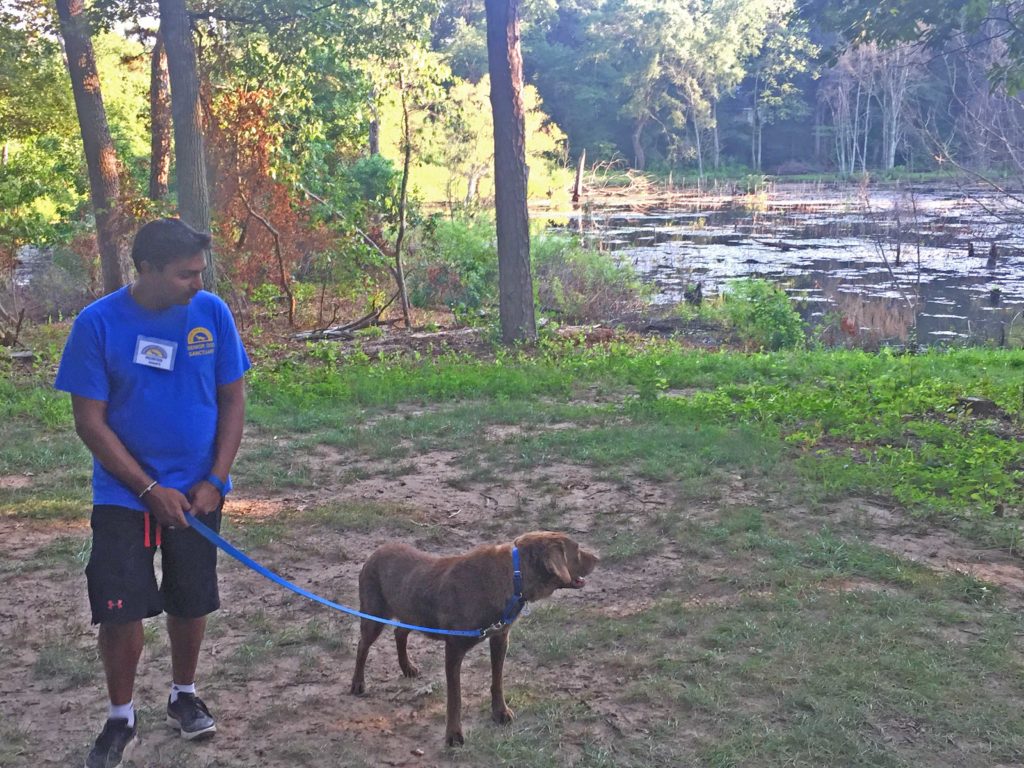Note: This is the fourth in a series of posts about what I learned while visiting the Senior Dog Sanctuary (SDS) in Severn, MD, and how it applies to Shep’s Place.
“Dogs come into our lives to teach us about love, they depart to teach us about loss.” Erica Jong
Near the end of my talk with Barb Turner, the Shelter Manager at SDS, we were sitting in her sunny office, discussing dog food, of all things, when she received a phone call. It was their vet, and the news was not good: one of their dogs, Marley, had untreatable cancer, and would not live much longer. Barb, who is as no-nonsense as they come, caught her breath and fought back tears. Marley was one of their dogs, one of her dogs, and she now had to face the impending loss of her friend.*
Facing the mortality of a loved one is difficult, whether it be for a person or a dog. As I’m typing these words, I am sitting in a waiting room at KU Med while my mother undergoes tests to determine what type of cancer she has. We fervently hope that she responds well to treatment, and still has a long life ahead of her. But at times like these, you can’t help but think about end of life issues, and how to manage them with grace.
For those who choose to work with older dogs, dealing with the end of life is part of the job. Even the best animal shelter cannot prevent dogs from aging and dying. But they can handle that time in a way that makes the process as comfortable, and comforting, for the dogs as possible. They can ensure that the dogs are ready to “cross the bridge” (as SDS calls it) with the dignity and respect they deserve.
As soon as Barb got off the phone, she began making arrangements for Marley to be moved out of the kennel and into the house. There she would be made comfortable, and showered with attention and affection. They also began to look for a person who could foster Marley in a “loving last home” (a nicer term than hospice). As long as she could be kept comfortable, they would care for her, and make sure she had the support and love she needed.
Comforting a dog at the end of her life was something I expected. It’s what happens afterwards at SDS that so impressed me. Dogs that pass away under their care are cremated, and their ashes are kept. Within the next year, SDS plans to build a Memorial Garden for the dogs, next to a beautiful pond near the entrance. There will be a low brick structure in the shape of an infinity symbol. On one side of the figure eight, they will place the ashes of the dogs who have passed, while on the other side, there will be benches and a fireplace. Donors can buy memorial bricks to remember their lost pets. It will be a visible sign of the respect that SDS has for the dogs whose lives they have touched.

The thing that really blew me away, though, was what SDS does with sick or injured strays. From time to time, Animal Control will call them about an old dog in such bad shape that the only humane thing to do is to euthanize it. Before that happens, though, people from SDS will pick up the dog and give it a Final Good Day, taking it to the park, buying it a hamburger, and giving it the love and attention it may never have had, before taking it to the vet and holding its paw while it passes away. Later, they will include that dog’s ashes in the Memorial Garden, along with those who lived at SDS. Oh, my, God, how amazingly sweet and noble is that! I cannot adequately express how touched I was by this. I don’t know how they do it; it makes me tear up just thinking about it. To show a dog they don’t even know that their life is worthy of respect, and to help them reach the bridge in as comforting and humane a way as possible… I was floored. It has to be a heart-wrenching task, but it’s so beautiful and so right.
While I was there, Val received a draft of a children’s book that is being written about SDS, called “Sugar Muzzles.” It tells the story of three actual dogs at SDS, from their point of view. During the long editing process, one of the dogs passed away, so the author added a final chapter about how the staff at SDS helped her get ready to “cross the bridge,” and how she was looking forward to whatever came next. It is a powerful lesson, even for children, that caring for dogs in their last days, and treating them with compassion, is the highest form of respect you can pay them. It is a great and remarkable service that SDS does for these dogs, and it represents the very best in the human spirit. It’s a lesson that Shep’s Place will take to heart.
*In my opinion, if someone does NOT feel sad when a dog dies, then part of their soul is missing. The sadness is proof of the deep compassion that makes Dog People so special.
